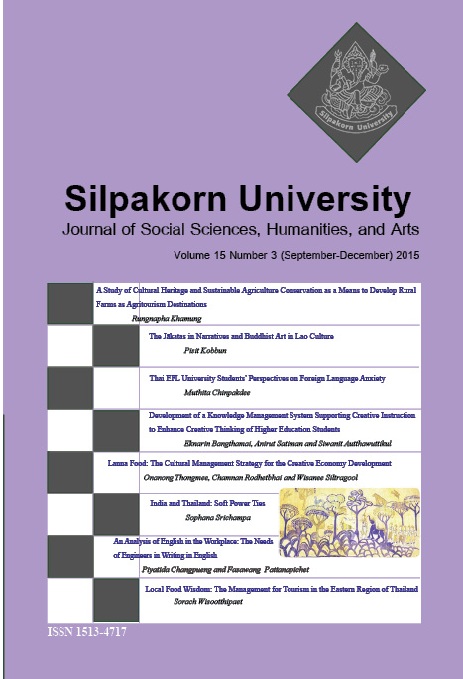Local Food Wisdom: The Management for Tourism in the Eastern Region of Thailand
Main Article Content
Abstract
The local food wisdom of the eastern region has a unique identity and is beneficial to the management for tourism promotion, yet is, currently, limitedly used. This research aimed to (1) study the history and development of the local food wisdom of the eastern region, (2) study the current situation and problems that affect the local food wisdom management for tourism promotion in the eastern region, and (3) study the local food wisdom management for tourism promotion in the eastern region; Rayong, Chantaburi, and Trad province. A quality research approach was applied in this study with these research tools: interview and observation guides, focus group discussion, and workshops. Data were collected by documentary and field research approaches, from 21 key informants, 30 causal informants, and 36 general informants. The triangulation method was applied to investigate the information gathered in order to analyze it to achieve the research goals. Descriptive analyze was used to present this study’s result.
The research results indicate that (1)The origin of the local food wisdom of the eastern region was generated from the habitation and utilization of the abundant natural resources of Chong, Chinese, and Vietnamese, including Indian and other groups living in the region, and from the intertwined ways of life which brought about cultural exchanges. These circumstances brought forth the characteristics of unique local foods with particular materials and spices and unique cooking techniques. The development of the local food wisdom of the eastern region is the consequence of economic and political development that caused changes to the people’s lifestyles, an increase in price of ingredients, and a decrease in the availability of several ingredients.
Nevertheless, the customs and use of local food materials in the eastern region; Rayong, Chantaburi, and Trad province has been adapted in a similar fashion to develop the unique characteristics: sitting round the food set and eating together, cooking strong and harmonious flavoured foods, spicy taste with seasonings and spices, and usually with the addition of sugar to meat dishes to harmonize the taste. Popular local dishes include pork curry with Chamuang (
Garcinia Cowa) leaves, stir fried rice noodles with crabmeat, Liang noodles (noodle with herbal soup with Rew or Tavoy cardamom), crab chili paste, etc.
Downloads
Article Details
All rights reserved. Apart from citations for the purposes of research, private study, or criticism and review,no part of this publication may be reproduced, stored or transmitted in any other form without prior written permission by the publisher.
References
Onnompan, E. (2002) Thai foods. Bangkok: Suan Dusit Rajabhat University.
Pengwan, T. (2006) Nutrition, Consuming Behaviour, and Nutritious Quality of Local Food Recipe: Case Study of the Basin of Hauy Rang-Khlong Peet, Trad Province, Dissertation. Bangkok: Kasetsart University.
Pitakpraiwan, K. (1991) Arts of Cooking of Various Nations. n.p.
Pornrungro, C. (2003) Khwamkit sangsan. Creative Thinking. Bangkok: Chulalongkorn University.
Santasombut, Y. (2005) Man and Culture. Bangkok: Thammasart University.
Sawetwimon, S. (1999) The Legend Thai Foods. Bangkok: Nanmee Books.
Wansiri, N. (1997) Social and Cultural Anthropology. Bangkok: Kasetsart University.
Wongthong, O. (1999) Technology of Drinks. Bangkok: Kasetsart University.


